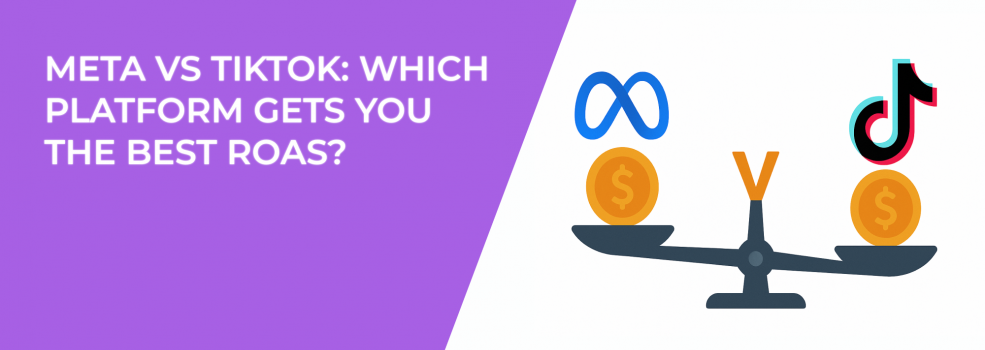Return on ad spend (ROAS) is the single metric many advertisers use to measure success. The big question in 2025 is whether Meta or TikTok delivers the stronger performance. Both platforms are massive. Both dominate in different ways. But where should you place your budget if the goal is efficiency and growth?
Let’s take a closer look.
Meta Advertising: Mature, Data-Driven, and Scalable
Meta’s advertising ecosystem (Facebook, Instagram, Messenger, and Audience Network) has matured into one of the most advanced targeting machines in digital marketing. Years of optimization, combined with billions of active users, give advertisers a huge testing ground.
Why do many businesses stick with Meta?
-
Wide audience reach: Meta covers a broad spectrum of demographics, from teenagers to retirees.
-
Robust targeting tools: Lookalikes, custom audiences, and retargeting are highly effective when campaigns are set up correctly.
-
Multiple ad formats: From Reels to Stories to carousel ads, you can adapt to nearly any stage of the funnel.
If you want to dive deeper into ad structures that maximize performance, see Meta Campaigns Explained: How to Structure High-Performance Campaigns.
Example use case 1: A subscription-based meal delivery service runs carousel ads showing different weekly menus. They use Meta’s lookalike audiences based on past subscribers, retarget site visitors, and follow up with a discount ad for those who abandoned checkout. The structured funnel drives a consistently higher ROAS because Meta supports retargeting at every step.
Example use case 2: A local real estate agency wants to promote open houses. On Meta, they can geo-target within a 10-mile radius, show listing videos in Stories, and retarget anyone who clicked for directions. That precise targeting translates into leads at a cost that’s hard to match on TikTok.
TikTok Advertising: Fast Growth and Cultural Relevance
TikTok has quickly become the go-to platform for short-form, attention-grabbing content. Its algorithm is famously sticky, pushing ads to users who may not even know they wanted the product until they see it.
So why do advertisers experiment heavily with TikTok?
-
High engagement rates: Users spend an average of 52 minutes a day on the platform, often in rapid-scroll sessions.
-
Lower CPMs: Compared to Meta, TikTok ads can be more affordable, which helps smaller brands stretch their budgets further.
-
Organic feel: Ads often blend into the feed as if they were user-generated content. This lowers resistance and boosts curiosity.
Example use case 1: A direct-to-consumer skincare startup launches a new serum. They create “before and after” TikTok videos paired with trending sounds. Influencers stitch the clips, and suddenly the campaign goes viral. Even with a modest budget, the brand enjoys outsized reach and a ROAS that rivals what they’ve achieved on Meta.
Example use case 2: A small apparel brand wants to reach Gen Z buyers. They run in-feed TikTok ads styled like regular outfit-of-the-day posts, using humor and trending audios. Instead of polished studio shots, the brand relies on casual, phone-shot content. The relatability boosts conversions and lowers acquisition costs.
For marketers targeting Gen Z or younger millennials, TikTok is worth a test. For insights on how Meta stacks up with younger demographics too, see How to Optimize Your Facebook Ad Targeting for Gen Z and Millennials.
ROAS Comparison: What Do the Numbers Say?
Statistics tell a mixed story.
-
A recent industry report showed that Meta campaigns deliver an average ROAS of 3.2, largely because of its mature retargeting system.
-
TikTok campaigns averaged a ROAS of 2.8, though many direct-to-consumer brands in beauty, fashion, and lifestyle industries see higher returns.
-
Cost per acquisition (CPA) on TikTok can be as much as 20–30% lower than Meta in competitive verticals.
Example scenario: A travel gear company advertises backpacks. On Meta, retargeting produces a ROAS of 4.1 because the company can reach shoppers who added items to their cart. On TikTok, the same campaign drives new customer discovery at scale, but ROAS sits around 2.5. The business realizes both platforms serve complementary purposes rather than competing head-to-head.
If you want to go beyond ROAS alone, read How to Analyze Campaign Performance Beyond ROAS: The Full Funnel View.
Which Platform Should You Choose?
Instead of treating the decision as an “either–or,” smart marketers often combine both. The platforms complement each other.
-
Use TikTok for top-of-funnel awareness, creative storytelling, and cultural relevance.
-
Lean on Meta for conversion-focused retargeting and proven scaling methods.
Blended strategy example: A fitness equipment brand sparks interest with fun TikTok videos showing quirky workout challenges. Once TikTok viewers engage with the content, the brand retargets them on Meta with structured product demos and limited-time offers. The combined funnel improves ROAS because TikTok brings in fresh attention, while Meta closes the sale.
Curious about how to structure a funnel like this? See Facebook Ads Funnel Strategy: From Audience Identification to Conversion.
Tips to Boost ROAS on Both Platforms
No matter where you run ads, certain practices will improve performance:
-
Test multiple creatives — Don’t assume one video or one image will work. Rotate often.
-
Leverage retargeting — Bring back those who clicked but didn’t buy.
-
Align content with platform culture — Use polished visuals on Meta, but lean into authenticity on TikTok.
-
Track cross-platform performance — Look at lifetime customer value, not just first-purchase ROAS.
-
Control frequency — Too many impressions too fast can cause fatigue, lowering returns.
If you’re struggling with declining results, check Ad Fatigue on Facebook: How to Spot It Early and Fix It Fast.
Practical example: A luxury watch retailer runs polished lifestyle ads on Meta to highlight craftsmanship. At the same time, they test playful, behind-the-scenes TikTok clips of the watch assembly process. Tracking both audiences, they notice that TikTok brings in affordable traffic, while Meta delivers the high-value purchases. Together, they achieve a balanced and profitable ROAS.
Final Thoughts
Meta offers scale and data-driven retargeting. TikTok offers cultural relevance and lower costs. Your best ROAS depends on your audience, product type, and how well your creatives match the platform’s user behavior.
The key isn’t choosing one over the other. It’s building a strategy that uses both platforms for what they do best. If you want efficiency, test carefully, measure honestly, and let the data guide you — not just the hype.
For more insights on adapting your ad strategy to this year’s changes, see Facebook Ads Targeting Updates: How To Adapt in 2025.

